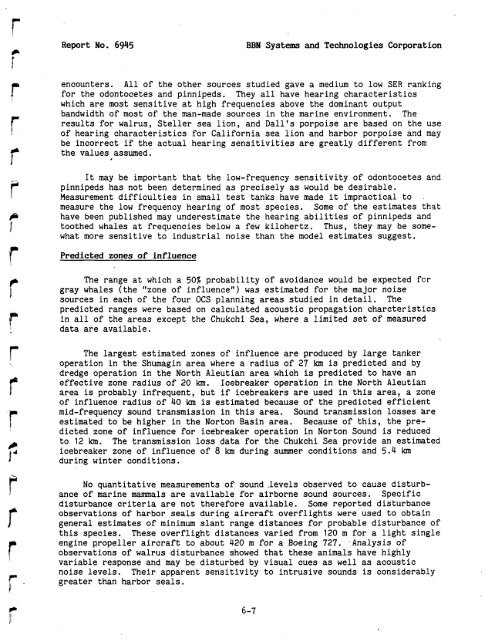Analysis and Ranking of the Acoustic Disturbance Potential of ...
Analysis and Ranking of the Acoustic Disturbance Potential of ...
Analysis and Ranking of the Acoustic Disturbance Potential of ...
Create successful ePaper yourself
Turn your PDF publications into a flip-book with our unique Google optimized e-Paper software.
Report No. 6945<br />
BBN Systems <strong>and</strong> Technologies Corporation<br />
encounters. All <strong>of</strong> <strong>the</strong> o<strong>the</strong>r sources studied gave a medium to low SER ranking<br />
for <strong>the</strong> odontocetes <strong>and</strong> pinnipeds. They all have hearing characteristics<br />
which are most sensitive at high frequencies above <strong>the</strong> dominant output<br />
b<strong>and</strong>width <strong>of</strong> most <strong>of</strong> <strong>the</strong> man-made sources in <strong>the</strong> marine environment. The<br />
results for walrus, Steller sea lion, <strong>and</strong> Dallls porpoise are based on <strong>the</strong> use<br />
<strong>of</strong> hearing characteristics for California sea lion <strong>and</strong> harbor porpoise <strong>and</strong> may<br />
be incorrect if <strong>the</strong> actual hearing sensitivities are greatly different from<br />
<strong>the</strong> values assumed.<br />
#<br />
It may be important that <strong>the</strong> low-frequency sensitivity <strong>of</strong> odontocetes <strong>and</strong><br />
pinnipeds has not been determined as precisely as would be desirable.<br />
Measurement difficulties in small test tanks have made it impractical to<br />
measure <strong>the</strong> low frequency hearing <strong>of</strong> most species. Some <strong>of</strong> <strong>the</strong> estimates that<br />
have been published may underestimate <strong>the</strong> hearing abilities <strong>of</strong> pinnipeds <strong>and</strong><br />
too<strong>the</strong>d whales at frequencies below a few kilohertz. Thus, <strong>the</strong>y may be somewhat<br />
more sensitive to industrial noise than <strong>the</strong> model estimates suggest.<br />
Predicted zones <strong>of</strong> influence<br />
The range at which a 50% probability <strong>of</strong> avoidance would be expected fcr<br />
gray whales (<strong>the</strong> "zone <strong>of</strong> influencet1) was estimated for <strong>the</strong> major noise<br />
sources in each <strong>of</strong> <strong>the</strong> four OCS planning areas studied in detail. The<br />
predicted ranges were based on calculated acoustic propagation charcteristics<br />
in all <strong>of</strong> <strong>the</strong> areas except <strong>the</strong> Chukchi Sea, where a limited set <strong>of</strong> measured<br />
data are available.<br />
The largest estimated zones <strong>of</strong> influence are produced by large tanker<br />
operation in <strong>the</strong> Shumagin area where a radius <strong>of</strong> 27 km is predicted <strong>and</strong> by<br />
dredge operation in <strong>the</strong> North Aleutian area which is predicted to have an<br />
effective zone radius <strong>of</strong> 20 km. Icebreaker operation in <strong>the</strong> North Aleutian<br />
area is probably infrequent, but if icebreakers are used in this area, a zone<br />
<strong>of</strong> influence radius <strong>of</strong> 40 km is estimated because <strong>of</strong> <strong>the</strong> predicted efficient<br />
mid-frequency sound transmission in this area. Sound transmission losses are<br />
estimated to be higher in <strong>the</strong> Norton Basin area. Because <strong>of</strong> this, <strong>the</strong> predicted<br />
zone <strong>of</strong> influence for icebreaker operation in Norton Sound is reduced<br />
to 12 km. The transmission loss data for <strong>the</strong> Chukchi Sea provide an estimated<br />
icebreaker zone <strong>of</strong> influence <strong>of</strong> 8 km during summer conditions <strong>and</strong> 5.4 km<br />
during winter conditions.<br />
No quantitative measurements <strong>of</strong> sound.levels observed to cause disturbance<br />
<strong>of</strong> marine mammals are available for airborne sound sources. Specific<br />
disturbance criteria are not <strong>the</strong>refore available. Some reported disturbance<br />
observations <strong>of</strong> harbor seals during aircraft overflights were used to obtain<br />
general estimates <strong>of</strong> minimum slant range distances for probable disturbance <strong>of</strong><br />
this species. These overflight distances varied from 120 m for a light single<br />
engine propeller aircraft to about 420 m for a Boeing 727. <strong>Analysis</strong> <strong>of</strong><br />
observations <strong>of</strong> walrus disturbance showed that <strong>the</strong>se animals have highly<br />
variable response <strong>and</strong> may be disturbed by visual cues as well as acoustic<br />
noise levels. Their apparent sensitivity to intrusive sounds is considerably<br />
greater than harbor seals.
















